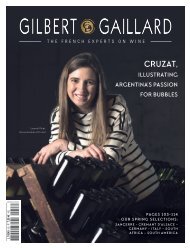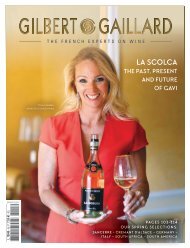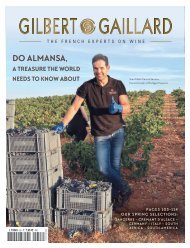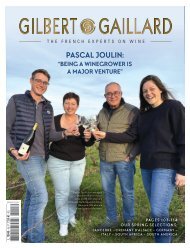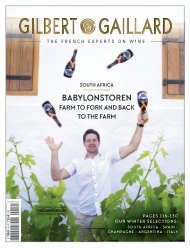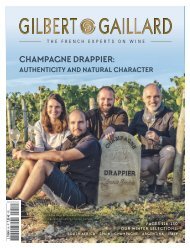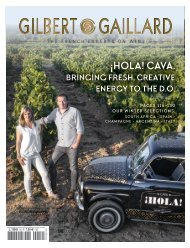Create successful ePaper yourself
Turn your PDF publications into a flip-book with our unique Google optimized e-Paper software.
SOUTH AFRICA<br />
NEW GENERATION<br />
WATERWISE<br />
VONDELING’S VINEYARDS RUN OFF THE SOUTH-FACING SLOPES OF THE PAARDEBERG<br />
MOUNTAIN WHERE THE DECOMPOSED GRANITE SOIL AND HABITUAL AFTERNOON SOUTH<br />
WESTERLY WINDS GIVE THE WINES VIBRANCY IN AN OTHERWISE WARM CLIMATE AREA<br />
ALMENKERK IN ELGIN IS HOME TO A SPECTACLE OF FAUNA AND FLORA AND THEY HAVE<br />
COMBINED ORCHARDS AND VINEYARDS TO EXPRESS THE DIVERSITY FOUND HERE<br />
A country like South Africa, struck by prolonged<br />
drought, has established a conservation consciousness<br />
throughout its wine value chain while<br />
maintaining the best possible quality in the most<br />
financially sustainable way. Vondeling viticulturalist,<br />
Magnus Joubert, believes this process<br />
starts in the soil, and a mixture of cover crops is<br />
used to preserve soil health. “This year, we used<br />
black oats (Saia oats), radish, mustard, vetch and<br />
lupines. This way, you cover a broader spectrum of<br />
material you put back in the soil: Saia gives green<br />
manure, radish helps with aeration, mustard helps<br />
protection against nematodes, and vetch provides<br />
good ground cover that helps with weed control<br />
and moisture retention in the soil. The lupines are<br />
a source of nitrogen fixation, and the cover crop<br />
keeps the soil alive. We use mulch in the form of<br />
Canola bales to help with moisture retention in the<br />
soil, and weed control. It breaks down to build soil<br />
health and build up carbon in the soil”.<br />
Graham Beck recycles all its sewerage water from<br />
the farm and cellar. “All recycled water is utilised<br />
for irrigation of the vineyards, amounting to about<br />
three million litres per month”, says Ferreira. “We<br />
have reduced our water usage to a maximum of<br />
6,000 m 3 per hectare yearly through constant and<br />
regular neutron moisture probe readings”.<br />
Spier became a WWF-SA Conservation Champion<br />
in 2012 and had been focusing on rehabilitating<br />
the riparian systems that flow through the farm.<br />
“This includes wetland rehabilitation, removing<br />
alien vegetation and planting indigenous riverine<br />
species that consume much less water”. Since<br />
establishing the Spier Nursery, it has planted over<br />
100,000 trees, shrubs, Fynbos, and over a million<br />
bulbs.<br />
When the Almenkerk-family acquired their Elgin<br />
estate in 2004, they decided to restore sections of<br />
the property to their original state, as identified in<br />
Botanist Helmes’ report of 2002. “Water was the<br />
first concern to arise, as the dam never filled its full<br />
potential during the rainy period”. Just by clearing<br />
alien vegetation to free water, did it freely start<br />
running into the dam during the rainy period,<br />
80 AUTUMN 2022 • GILBERT & GAILLARD - THE FRENCH EXPERTS ON WINE









